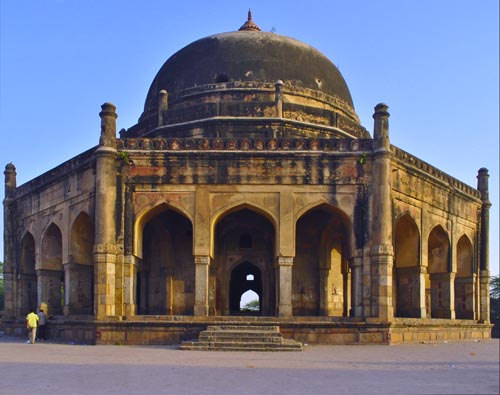Adam Khan Tomb

Information on Adam Khan Tomb (New Delhi) - History & Architecture
The tomb of Adam Khan is referred to as Bhool Bhulaiya and is located just at the back of the famous structure, Qutub Minar which faces the bus stand in Mehrauli, Delhi. Bhool Bhulaiya actually means labyrinth or maze. Adam Khan served as a general in the Mughal army during the reign of Akabar, the eminent Mughal Emperor. The place or rather the structure is given imperative significance as it is believed that once an entire lot of wedding attendees taking shelter in the Bhool Bhulaiya went missing inside it. The structure is encircled with thick woodlands of Lal Kot or Qila Rai Pithora, another historical fort.
Adam Khan Tomb Architecture
Bhool Bhulaiya is regarded as an astonishing monument and is supposed to be among the few structures that are known to presently subsist from the age of Akbar. Bhool Bhulaiya is identified to be a monument with amazing style of architecture and is thus, known as a marvel. The mausoleum stands tall on the fortification of an age-old Rajput fortess, Lal Kot. The mausoleum is huge and octagonal in design and includes a sole, broad dome. The mausoleum is learnt to have been constructed in accordance with the Lodhi as well as Sayyid pattern of architecture. The monument is 5 metres in height with petite minarets placed on all the eight sides. The tomb is made of grey coloured sandstone however, the dome on the top has been built with red coloured sandstone. A verandah runs on each of the sides penetrated by three apertures. There are numerous passages or rather corridors which act as a maze. The main hall area of the mausoleum houses the reinstated grave of Adam Khan as the original grave was demolished. The mausoleum also includes the grave of Adam Khan's mother but the exact position of it has been presently misplaced. An essential feature of the monument which is worth noting is the design of the mausoleum. The evident octagonal pattern was quite unlikely in comparison to the Mughal structure of buildings during that era. It is believed that an octagonal design was possibly assigned to the tomb of the traitors or conspirators. The octagonal pattern was observed to be a widespread characteristic found in the mausoleums of the earlier Lodhi dynasty as well as Sur dynasty which were perceived as betrayers by the Mughals.
Adam Khan Tomb History
The mausoleum was constructed in the year 1561 AD and is on the northern side of the Qutub Minar in Mehrauli, Delhi. The structure is considered to be a monument of great historic significance and is thus, presently guarded by the Archaeological Survey of India (ASI). Adam Khan was the son of Akbar's foster mother, Maham Anga and was a traitor as he planned the execution of Ataga Khan, another general who was Akbar's preferred. Akbar, on knowing about the grave conspiracy, ordered the execution of Adam Khan and he was twice pushed from the summit of the Agra Fort and which resulted in leaving his mother emotionally instable. Maham Anga also died owing to her son's grief barely within a month or so of his death. Akbar then had this structure erected in the remembrance of Maham Anga and Adam Khan. During the period of 1830, a British official named Blake moved away the graves of Adam Khan and Maham Anga while transforming the mausoleum into his residence. It was later on used as a post office, police station and even as a resting house by the British and was later restored on the instructions of Viceroy Lord Curzon. The restoration of Adam Khan's tomb was done successfully however, the same was not possible for Maham Anga's grave.
Adam Khan Tomb Tourism Significance
The unique structure of corridors making it a labyrinth is supposed to be quite an interesting feature of the mausoleum. The exceptional architectural style, structure along with tranquil and serene atmosphere of the mausoleum attracts quite a significant number of tourists from across the world. The history of Adam Khan also catches the interest of the visitors which makes it necessary for them to visit the structure.
- Andaman Nicobar Monuments
- Andhra Pradesh Monuments
- Assam Monuments
- Bihar Monuments
- Chhattisgarh Monuments
- New Delhi Monuments
- Goa Monuments
- Gujarat Monuments
- Haryana Monuments
- Himachal Pradesh Monuments
- Jammu and Kashmir Monuments
- Karnataka Monuments
- Kerala Monuments
- Madhya Pradesh Monuments
- Maharashtra Monuments
- Odisha Monuments
- Punjab Monuments
- Rajasthan Monuments
- Tamil Nadu Monuments
- Telangana Monuments
- Uttar Pradesh Monuments
- West Bengal Monuments